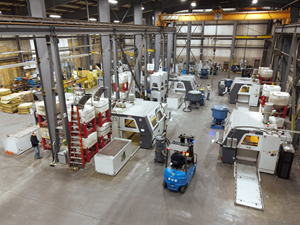WASP Develops Sustainable Solutions for Additive Manufacturing
Formnext 2024: Italy-based Wasp has developed technological solutions for additive manufacturing (AM) which are centered on sustainability, precision and creative freedom. This includes printing 100% recycled plastic directly from shreds, dynamically controlling pellet coloring and testing advanced geopolymer materials for reduced CO2 emissions.
WASP has developed a variety of technological solutions centered on sustainability, precision and creative freedom, including plastic waste recycling, a controlled multicolor pellet extrusion system, large-scale high-definition printing from plastic granules and a large-scale pellet extruder for robotic arm 3D printing.
3D Printing Recycling Station
WASP’s Rigenera 3D printing recycling station can print directly from recycled in-house shredded plastics that are compatible with all extruders in the WASP HDP line. Source (all images): WASP
WASP’s Rigenera 3D printing recycling station is a circular recycling system for plastic materials developed as the company focused on how to reuse large 3D printed parts. This extrusion system is capable of printing directly from recycled in-house shredded plastics that are compatible with all extruders in the WASP HDP line.
The recycling station is where disposed objects, faulty pieces and waste materials are collected, shredded and reprinted into new, functional products, giving new life to waste. The system consists of a series of tools that, when used together, enable manufacturers to manage the entire recycling process from start to finish.
Tools include:
- Bins for waste and defective parts
- Chain saw
- Plastic shredder
- Dehumidifier
- WASP HDP Printer/Extruder on Robotic arm with Cerebro
Controlled Multicolor Pellet Extrusion System
The Metamorfosi controlled multicolor pellet extrusion system is capable of dynamically controlling and modifying the position, quantity and hue of color during the printing process. It is designed to enable precise control through an app that manages the dosing of pigments within the melting chamber. Utilizing the colors cyan, magenta, yellow and key (black) enables the generation of a full spectrum of color ranges while the machine is printing. This method also enables real-time adjustments and blending of hues, which can result in dynamic and vibrant outputs.
The Metamorfosi is compatible with WASP’s AiBuild 3D printing software to enhance the precision and efficiency in 3D printing thanks to the integration with its advanced slicing software. This hybrid software enables 3D printing and CNC machining together in one secure platform. With centralized control of machines to reduce lead times, cuts costs and eliminate inefficiencies, it drives precision, speed and quality throughout production.
Large Scale High-Definition Printing From Plastic Granules
The Power WASP 45 HDP is a large-scale fused granulate fabrication (FGF) 3D printer designed to print at 45 degrees, enabling the creation of complex geometries and perform retractions. It is well suited for customized technical prints tailored for the nautical sector, offering precision and durability for marine applications. This 45-degree approach reduces the need for supports, as layers naturally self-support, which minimizes material use and enhances surface quality. Additionally, it distributes cooling stresses more evenly across prints, thereby reducing shrinkage and warping, and achieving faster heat dissipation.
Large-Scale Pellet Extruder for Robotic Arm 3D Printing
The WASP Extruder HDP XXL is an FGF extruder for large-scale applications. It features High-Definition Pellet (HDP) technology, which enables direct printing from thermoplastic pellets. Designed to be used with robotic arms, it works in conjunction with Cerebro, the integration system for robotic arms and WASP’s extruders. The extruder is compatible with the Rigenera extrusion system, which enables printing directly from 100% in-house recycled plastic shreds. Unlike traditional extruders, it can process various sizes of plastic by removing metal impurities.
Related Content
Video: 3D Printed Tooling Eases Cobot Integration
At NPE 2024, Universal Robots and EMI Corporation highlighted how 3D printed end effectors, fixtures and more enable adoption of collaborative robots.
Read MoreVideo: 5" Diameter Navy Artillery Rounds Made Through Robot Directed Energy Deposition (DED) Instead of Forging
Big Metal Additive conceives additive manufacturing production factory making hundreds of Navy projectile housings per day.
Read More8 Cool Parts From Formnext 2023: The Cool Parts Show #65
New additive manufacturing technologies on display at Formnext were in many cases producing notable end-use components. Here are some of the coolest parts we found at this year’s show.
Read MoreLooking to Secure the Supply Chain for Castings? Don't Overlook 3D Printed Sand Cores and Molds
Concerns about casting lead times and costs have many OEMs looking to 3D print parts directly in metal. But don’t overlook the advantages of 3D printed sand cores and molds applied for conventional metal casting, says Humtown leader.
Read MoreRead Next
Postprocessing Steps and Costs for Metal 3D Printing
When your metal part is done 3D printing, you just pull it out of the machine and start using it, right? Not exactly.
Read MoreCrushable Lattices: The Lightweight Structures That Will Protect an Interplanetary Payload
NASA uses laser powder bed fusion plus chemical etching to create the lattice forms engineered to keep Mars rocks safe during a crash landing on Earth.
Read MoreAlquist 3D Looks Toward a Carbon-Sequestering Future with 3D Printed Infrastructure
The Colorado startup aims to reduce the carbon footprint of new buildings, homes and city infrastructure with robotic 3D printing and a specialized geopolymer material.
Read More






















